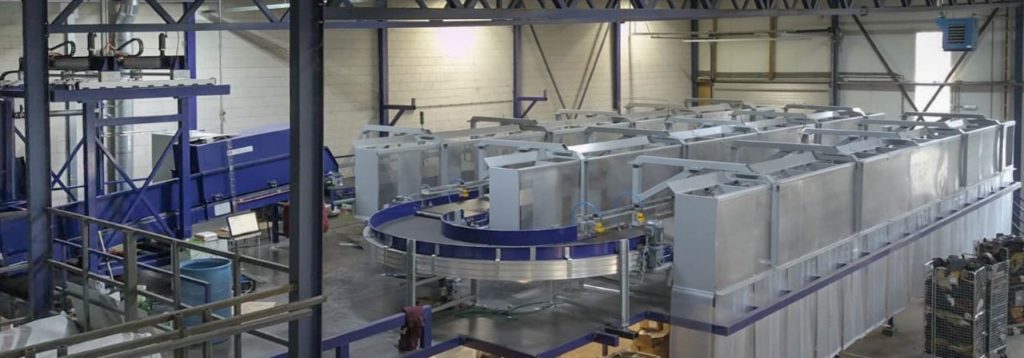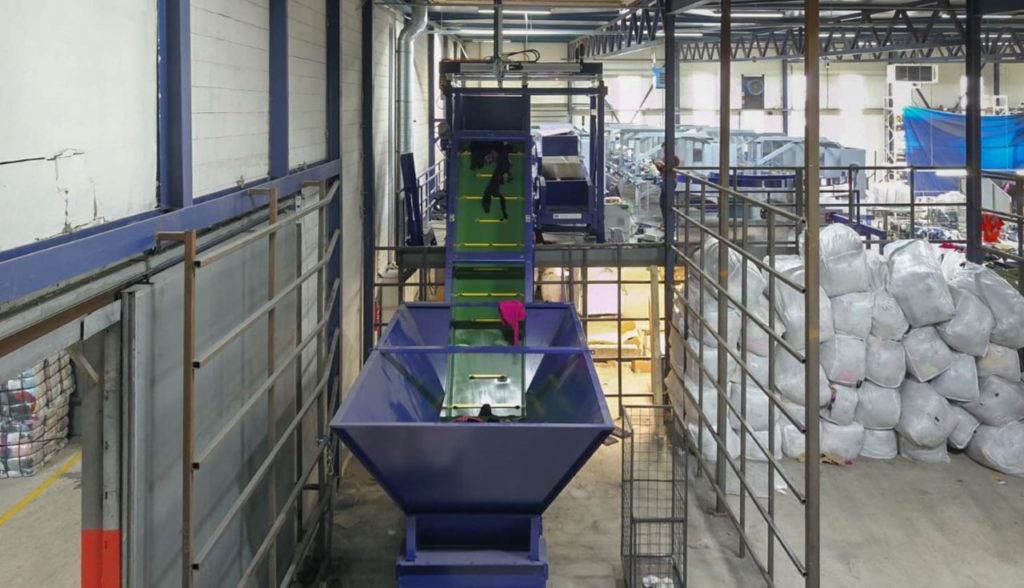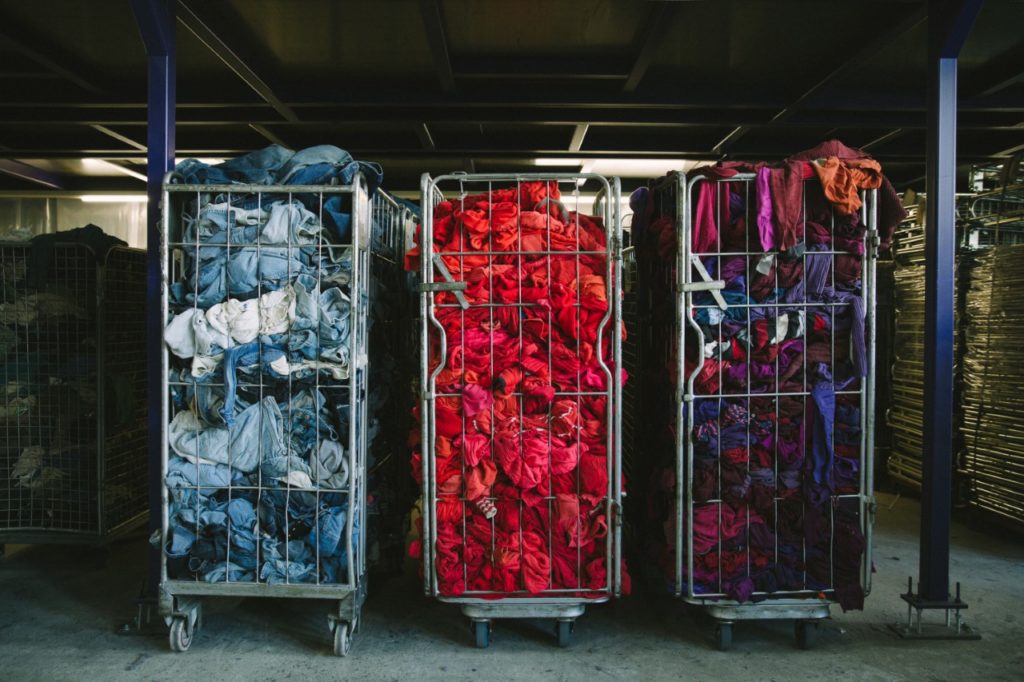The Technology

-
The Fibersort is a technology that automatically sorts large volumes of mixed textiles by fiber composition. The machine makes a prediction of the fiber concentration of each of the following fibers: wool, cotton, polyester, acrylic, viscose and nylon. Based on the thresholds set on the machine different categories can be defined on the fiber concentration prediction.
A color camera takes pictures of the textiles to be able to sort the both on fiber composition and color. The machine is running today with more than 20 different color tones configured but this number can be much higher. The machine can sort distinct colors very accurately. Today the machine detects the following colors : black, dark grey, grey, light grey, white, ecru, dark red, red, light red, dark blue, blue, light blue, pink, etc. The camera can also make a distinction between single and multi-color textiles.
The fiber prediction scanning technology is based on NIR Spectroscopy, based on molecular absorptions measured in the Near Infrared part of the spectrum. This technique is sensitive to organic constituents and since all textile is organic, there is no limit to the types of fiber that can be recognized.
Currently, at the Smart Fibersorting facility, it sorts into 45 different categories, but this can be adjusted to match the needs of the sorter. Once these materials are sorted they become reliable, consistent input materials for high value textile to textile recyclers. More details on the technology can be found in this report , this poster , and by contacting Valvan Baling Systems.
-
The layout at Smart Fibersorting with 45 categories is 30m x 15m. A basic line with manual sorting and 6 categories is 15m x 8m.
-
The nominal power consumption for the Fibersort with 45 categories and automated feeding is 15kW.
-
The Fibersort machine records all types of data during production. The scanner and camera data is recorded to improve the machine learning algorithms, and the production data is recorded to get insights in the different products and efficiency of the machine.
-
Since this process requires a feed of one piece at a time, the supply of the textiles to the system must also be piece by piece. This was previously done manually by an operator that takes the items from a pile and puts them piece by piece on a conveyor belt, a substantially repetitive and physically challenging task when attempting to keep a constant pace. This operation was therefore replaced by an automated feed-in system with robot arms, that allows to feed a constant flow of textiles to the Fibersort scanner and keep productivity at 1.5 sec/ piece of clothing (with 2 robot arms in place). The previous process of manual sorting to separate rewearables (second-hand market) and non-rewearables is kept unchanged and therefore, the negative impact in jobs is significantly low. It could even foster creation of new jobs.
The feedstock

-
The Fibersort machine is fed non-rewearable mono-material used textiles that have been collected through diverse municipal and private textile collection schemes.
-
The Fibersort technology can only scan one layer of material at a time, meaning that only mono-materials should be fed into the machine, to avoid subsequent contamination in the sorted categories.
-
Currently, the Fibersort has not been taught to recognise elastane composition. Nevertheless, as it has been done with all of the other fibre compositions this can be done and is a process of training the technology to recognize the specific material.
-
The machine recognizes blended materials for the fibre composition that it has been taught to recognize. At the moment this is wool, acrylic, cotton, polyester, polyamide and viscose and their blends. The scanning technology used is NIR Spectroscopy, based on molecular absorptions measured in the Near Infrared part of the spectrum. NIR technology and modern machine learning algorithms determine what percentage of each material is present in the blend.
-
The Fibersort does not recognize coated fabrics or yarns. Such coatings are mostly applied on materials that are not suitable for the Fibersort (e.g. jackets), so the project partners did not include such materials in the scope of this project.
The outputs

-
The output of the machine are bales of sorted textiles by fiber and/or color composition. There are currently 45 categories for these sorted textiles that combine composition and color.
-
At the moment, 60 per cent of the textiles that pass over the machine, are sorted in one of the 45 categories. The other 40 per cent does not belong to any of the 45 configured categories and is considered as too low value to sort into a category today. In different setups, locations, uses, etc. this percentage could be higher or lower depending on how the machine is configured.
The non-sorted textiles go into category 46 ‘the rest bin’ and are sold for lower value applications (e.g. down-cycling). The remaining textiles after that are handled as waste and disposed of accordingly, as they have currently no market available.
-
The Fibersort machine does not remove any hardware, fastenings or trimmings. During the trials conducted throughout the Interreg NWE project this was done manually, and the removed components were not recycled. Hardware removal both manually and by different mechanical technologies needs to be further assessed technically and financially to make informed decisions for scaling these processes. The resulting reuse or recycling of removed components may also be an interesting factor in proving the business case for this activity.
-
Many interesting and useful insights have arisen from this project. Facts and analysis regarding material specifications can be found in our ‘Manual sort of post-consumer textiles’, our report on’ Recycled post-consumer textiles’ as well as our latest case studies report ‘Overcoming the barriers for long-term implementation’.
Worn Again used the results from the Fibersort sorting trials to establish the feedstock specification that their enhanced recycling process can take in: pure polyester & polycotton/polycellulose blends with up to 80% cotton content and a maximum of 10 per cent tolerance for other materials. and/or color composition. There are currently 45 categories for these sorted textiles that combine composition and color.
